Strategic Plan Analysis and Evaluation for Hilton Hotel Expansion
VerifiedAdded on 2020/10/22
|16
|4288
|370
Report
AI Summary
This report provides a comprehensive analysis of the strategic plan of Hilton Hotel, a leading global hospitality brand. It begins by defining strategic analysis and its importance in the hospitality industry, emphasizing customer orientation and market trends. The report examines Hilton's strategic options, including franchising, management contracts, joint ventures, and mergers and acquisitions, detailing their benefits and drawbacks. It then delves into the factors affecting strategic implementation, such as leadership, structural design, information and control systems, and human resources. The report also evaluates performance metrics like critical success factors, key performance indicators, and the balance scorecard, crucial for assessing the effectiveness of Hilton's strategies. The analysis highlights Hilton's expansion strategies, including its franchising model, management contracts, and joint ventures, providing insights into the company's approach to global growth and market adaptation.
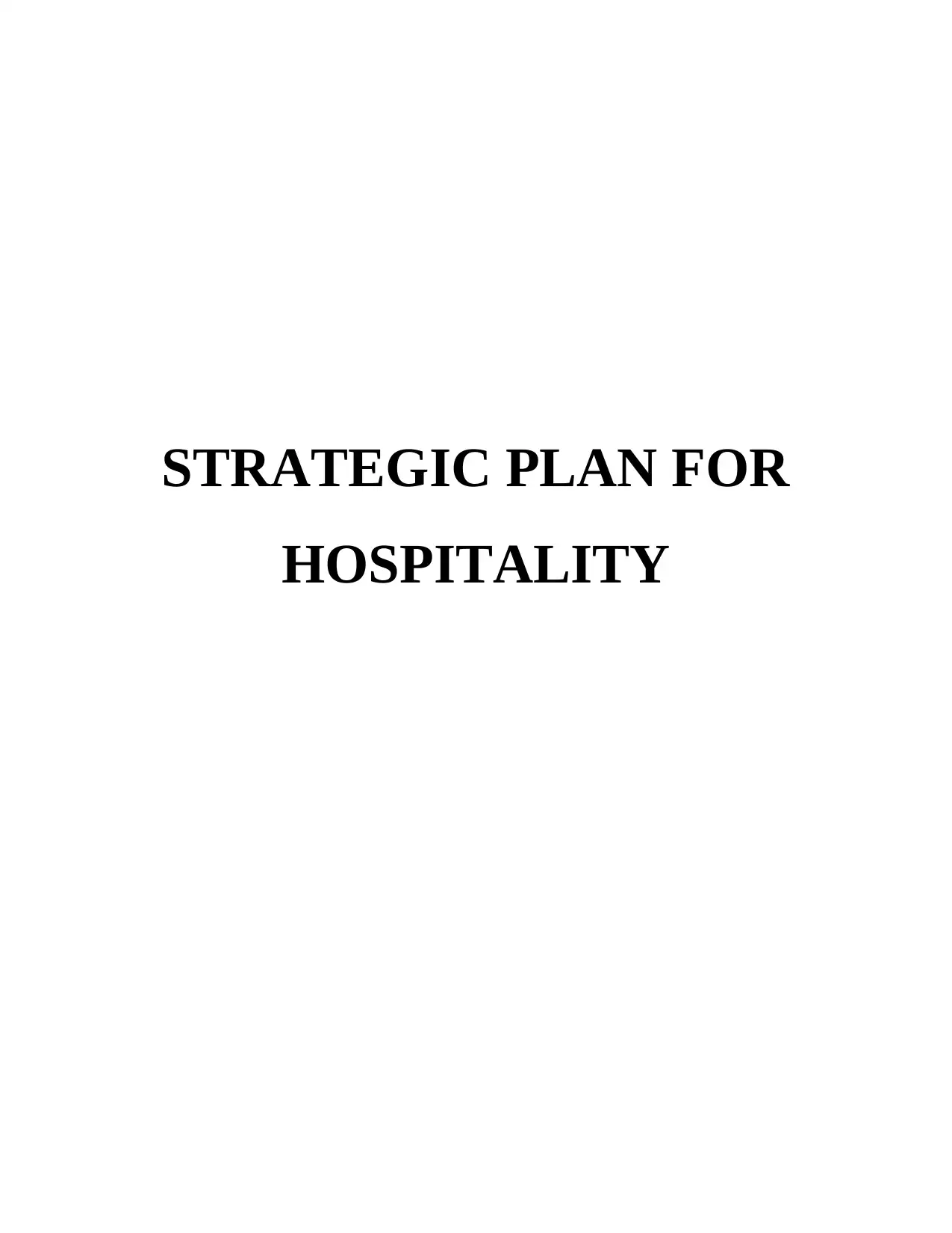
STRATEGIC PLAN FOR
HOSPITALITY
HOSPITALITY
Paraphrase This Document
Need a fresh take? Get an instant paraphrase of this document with our AI Paraphraser
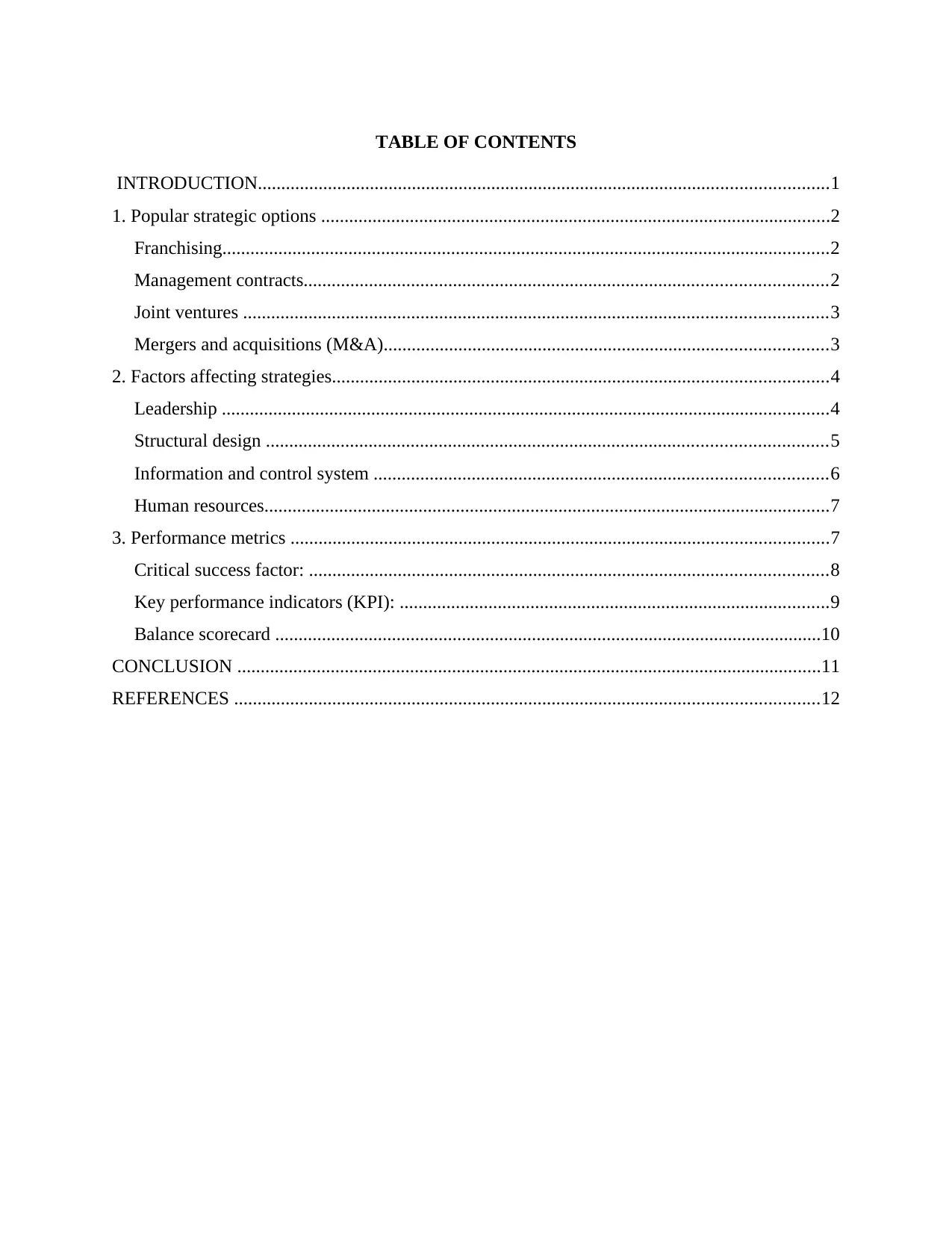
TABLE OF CONTENTS
INTRODUCTION..........................................................................................................................1
1. Popular strategic options .............................................................................................................2
Franchising..................................................................................................................................2
Management contracts................................................................................................................2
Joint ventures .............................................................................................................................3
Mergers and acquisitions (M&A)...............................................................................................3
2. Factors affecting strategies..........................................................................................................4
Leadership ..................................................................................................................................4
Structural design ........................................................................................................................5
Information and control system .................................................................................................6
Human resources.........................................................................................................................7
3. Performance metrics ...................................................................................................................7
Critical success factor: ...............................................................................................................8
Key performance indicators (KPI): ............................................................................................9
Balance scorecard .....................................................................................................................10
CONCLUSION .............................................................................................................................11
REFERENCES .............................................................................................................................12
INTRODUCTION..........................................................................................................................1
1. Popular strategic options .............................................................................................................2
Franchising..................................................................................................................................2
Management contracts................................................................................................................2
Joint ventures .............................................................................................................................3
Mergers and acquisitions (M&A)...............................................................................................3
2. Factors affecting strategies..........................................................................................................4
Leadership ..................................................................................................................................4
Structural design ........................................................................................................................5
Information and control system .................................................................................................6
Human resources.........................................................................................................................7
3. Performance metrics ...................................................................................................................7
Critical success factor: ...............................................................................................................8
Key performance indicators (KPI): ............................................................................................9
Balance scorecard .....................................................................................................................10
CONCLUSION .............................................................................................................................11
REFERENCES .............................................................................................................................12
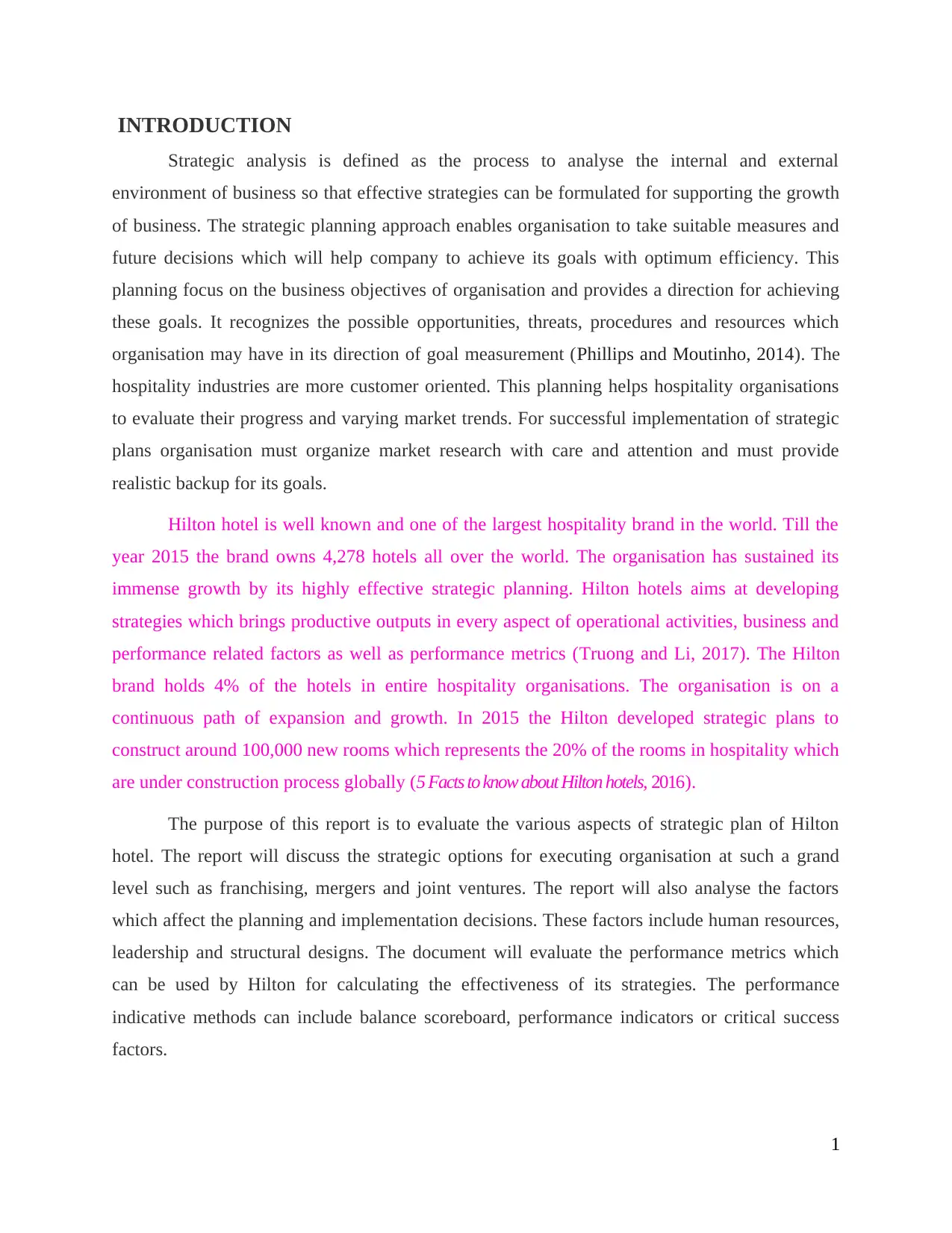
INTRODUCTION
Strategic analysis is defined as the process to analyse the internal and external
environment of business so that effective strategies can be formulated for supporting the growth
of business. The strategic planning approach enables organisation to take suitable measures and
future decisions which will help company to achieve its goals with optimum efficiency. This
planning focus on the business objectives of organisation and provides a direction for achieving
these goals. It recognizes the possible opportunities, threats, procedures and resources which
organisation may have in its direction of goal measurement (Phillips and Moutinho, 2014). The
hospitality industries are more customer oriented. This planning helps hospitality organisations
to evaluate their progress and varying market trends. For successful implementation of strategic
plans organisation must organize market research with care and attention and must provide
realistic backup for its goals.
Hilton hotel is well known and one of the largest hospitality brand in the world. Till the
year 2015 the brand owns 4,278 hotels all over the world. The organisation has sustained its
immense growth by its highly effective strategic planning. Hilton hotels aims at developing
strategies which brings productive outputs in every aspect of operational activities, business and
performance related factors as well as performance metrics (Truong and Li, 2017). The Hilton
brand holds 4% of the hotels in entire hospitality organisations. The organisation is on a
continuous path of expansion and growth. In 2015 the Hilton developed strategic plans to
construct around 100,000 new rooms which represents the 20% of the rooms in hospitality which
are under construction process globally (5 Facts to know about Hilton hotels, 2016).
The purpose of this report is to evaluate the various aspects of strategic plan of Hilton
hotel. The report will discuss the strategic options for executing organisation at such a grand
level such as franchising, mergers and joint ventures. The report will also analyse the factors
which affect the planning and implementation decisions. These factors include human resources,
leadership and structural designs. The document will evaluate the performance metrics which
can be used by Hilton for calculating the effectiveness of its strategies. The performance
indicative methods can include balance scoreboard, performance indicators or critical success
factors.
1
Strategic analysis is defined as the process to analyse the internal and external
environment of business so that effective strategies can be formulated for supporting the growth
of business. The strategic planning approach enables organisation to take suitable measures and
future decisions which will help company to achieve its goals with optimum efficiency. This
planning focus on the business objectives of organisation and provides a direction for achieving
these goals. It recognizes the possible opportunities, threats, procedures and resources which
organisation may have in its direction of goal measurement (Phillips and Moutinho, 2014). The
hospitality industries are more customer oriented. This planning helps hospitality organisations
to evaluate their progress and varying market trends. For successful implementation of strategic
plans organisation must organize market research with care and attention and must provide
realistic backup for its goals.
Hilton hotel is well known and one of the largest hospitality brand in the world. Till the
year 2015 the brand owns 4,278 hotels all over the world. The organisation has sustained its
immense growth by its highly effective strategic planning. Hilton hotels aims at developing
strategies which brings productive outputs in every aspect of operational activities, business and
performance related factors as well as performance metrics (Truong and Li, 2017). The Hilton
brand holds 4% of the hotels in entire hospitality organisations. The organisation is on a
continuous path of expansion and growth. In 2015 the Hilton developed strategic plans to
construct around 100,000 new rooms which represents the 20% of the rooms in hospitality which
are under construction process globally (5 Facts to know about Hilton hotels, 2016).
The purpose of this report is to evaluate the various aspects of strategic plan of Hilton
hotel. The report will discuss the strategic options for executing organisation at such a grand
level such as franchising, mergers and joint ventures. The report will also analyse the factors
which affect the planning and implementation decisions. These factors include human resources,
leadership and structural designs. The document will evaluate the performance metrics which
can be used by Hilton for calculating the effectiveness of its strategies. The performance
indicative methods can include balance scoreboard, performance indicators or critical success
factors.
1
⊘ This is a preview!⊘
Do you want full access?
Subscribe today to unlock all pages.

Trusted by 1+ million students worldwide
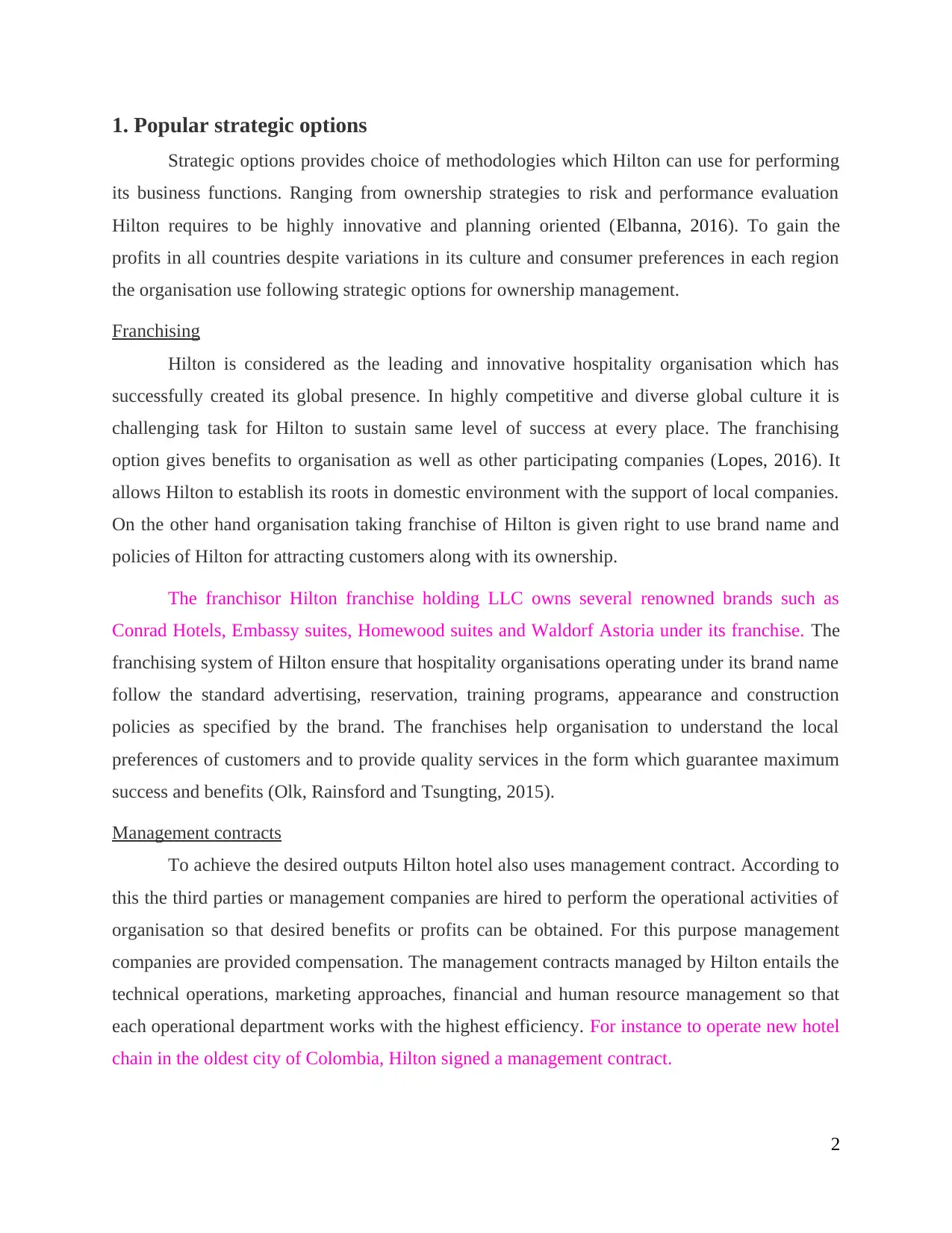
1. Popular strategic options
Strategic options provides choice of methodologies which Hilton can use for performing
its business functions. Ranging from ownership strategies to risk and performance evaluation
Hilton requires to be highly innovative and planning oriented (Elbanna, 2016). To gain the
profits in all countries despite variations in its culture and consumer preferences in each region
the organisation use following strategic options for ownership management.
Franchising
Hilton is considered as the leading and innovative hospitality organisation which has
successfully created its global presence. In highly competitive and diverse global culture it is
challenging task for Hilton to sustain same level of success at every place. The franchising
option gives benefits to organisation as well as other participating companies (Lopes, 2016). It
allows Hilton to establish its roots in domestic environment with the support of local companies.
On the other hand organisation taking franchise of Hilton is given right to use brand name and
policies of Hilton for attracting customers along with its ownership.
The franchisor Hilton franchise holding LLC owns several renowned brands such as
Conrad Hotels, Embassy suites, Homewood suites and Waldorf Astoria under its franchise. The
franchising system of Hilton ensure that hospitality organisations operating under its brand name
follow the standard advertising, reservation, training programs, appearance and construction
policies as specified by the brand. The franchises help organisation to understand the local
preferences of customers and to provide quality services in the form which guarantee maximum
success and benefits (Olk, Rainsford and Tsungting, 2015).
Management contracts
To achieve the desired outputs Hilton hotel also uses management contract. According to
this the third parties or management companies are hired to perform the operational activities of
organisation so that desired benefits or profits can be obtained. For this purpose management
companies are provided compensation. The management contracts managed by Hilton entails the
technical operations, marketing approaches, financial and human resource management so that
each operational department works with the highest efficiency. For instance to operate new hotel
chain in the oldest city of Colombia, Hilton signed a management contract.
2
Strategic options provides choice of methodologies which Hilton can use for performing
its business functions. Ranging from ownership strategies to risk and performance evaluation
Hilton requires to be highly innovative and planning oriented (Elbanna, 2016). To gain the
profits in all countries despite variations in its culture and consumer preferences in each region
the organisation use following strategic options for ownership management.
Franchising
Hilton is considered as the leading and innovative hospitality organisation which has
successfully created its global presence. In highly competitive and diverse global culture it is
challenging task for Hilton to sustain same level of success at every place. The franchising
option gives benefits to organisation as well as other participating companies (Lopes, 2016). It
allows Hilton to establish its roots in domestic environment with the support of local companies.
On the other hand organisation taking franchise of Hilton is given right to use brand name and
policies of Hilton for attracting customers along with its ownership.
The franchisor Hilton franchise holding LLC owns several renowned brands such as
Conrad Hotels, Embassy suites, Homewood suites and Waldorf Astoria under its franchise. The
franchising system of Hilton ensure that hospitality organisations operating under its brand name
follow the standard advertising, reservation, training programs, appearance and construction
policies as specified by the brand. The franchises help organisation to understand the local
preferences of customers and to provide quality services in the form which guarantee maximum
success and benefits (Olk, Rainsford and Tsungting, 2015).
Management contracts
To achieve the desired outputs Hilton hotel also uses management contract. According to
this the third parties or management companies are hired to perform the operational activities of
organisation so that desired benefits or profits can be obtained. For this purpose management
companies are provided compensation. The management contracts managed by Hilton entails the
technical operations, marketing approaches, financial and human resource management so that
each operational department works with the highest efficiency. For instance to operate new hotel
chain in the oldest city of Colombia, Hilton signed a management contract.
2
Paraphrase This Document
Need a fresh take? Get an instant paraphrase of this document with our AI Paraphraser
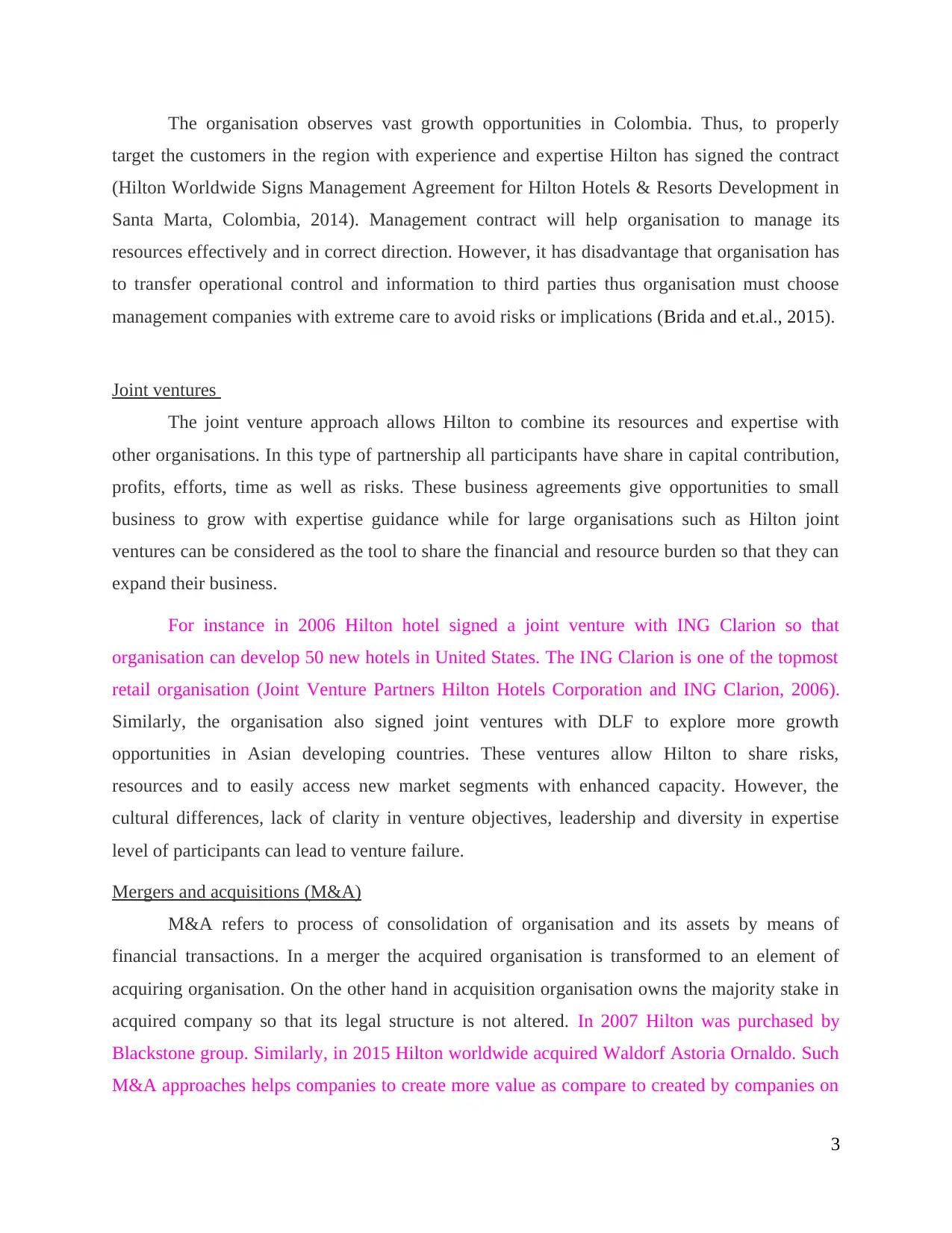
The organisation observes vast growth opportunities in Colombia. Thus, to properly
target the customers in the region with experience and expertise Hilton has signed the contract
(Hilton Worldwide Signs Management Agreement for Hilton Hotels & Resorts Development in
Santa Marta, Colombia, 2014). Management contract will help organisation to manage its
resources effectively and in correct direction. However, it has disadvantage that organisation has
to transfer operational control and information to third parties thus organisation must choose
management companies with extreme care to avoid risks or implications (Brida and et.al., 2015).
Joint ventures
The joint venture approach allows Hilton to combine its resources and expertise with
other organisations. In this type of partnership all participants have share in capital contribution,
profits, efforts, time as well as risks. These business agreements give opportunities to small
business to grow with expertise guidance while for large organisations such as Hilton joint
ventures can be considered as the tool to share the financial and resource burden so that they can
expand their business.
For instance in 2006 Hilton hotel signed a joint venture with ING Clarion so that
organisation can develop 50 new hotels in United States. The ING Clarion is one of the topmost
retail organisation (Joint Venture Partners Hilton Hotels Corporation and ING Clarion, 2006).
Similarly, the organisation also signed joint ventures with DLF to explore more growth
opportunities in Asian developing countries. These ventures allow Hilton to share risks,
resources and to easily access new market segments with enhanced capacity. However, the
cultural differences, lack of clarity in venture objectives, leadership and diversity in expertise
level of participants can lead to venture failure.
Mergers and acquisitions (M&A)
M&A refers to process of consolidation of organisation and its assets by means of
financial transactions. In a merger the acquired organisation is transformed to an element of
acquiring organisation. On the other hand in acquisition organisation owns the majority stake in
acquired company so that its legal structure is not altered. In 2007 Hilton was purchased by
Blackstone group. Similarly, in 2015 Hilton worldwide acquired Waldorf Astoria Ornaldo. Such
M&A approaches helps companies to create more value as compare to created by companies on
3
target the customers in the region with experience and expertise Hilton has signed the contract
(Hilton Worldwide Signs Management Agreement for Hilton Hotels & Resorts Development in
Santa Marta, Colombia, 2014). Management contract will help organisation to manage its
resources effectively and in correct direction. However, it has disadvantage that organisation has
to transfer operational control and information to third parties thus organisation must choose
management companies with extreme care to avoid risks or implications (Brida and et.al., 2015).
Joint ventures
The joint venture approach allows Hilton to combine its resources and expertise with
other organisations. In this type of partnership all participants have share in capital contribution,
profits, efforts, time as well as risks. These business agreements give opportunities to small
business to grow with expertise guidance while for large organisations such as Hilton joint
ventures can be considered as the tool to share the financial and resource burden so that they can
expand their business.
For instance in 2006 Hilton hotel signed a joint venture with ING Clarion so that
organisation can develop 50 new hotels in United States. The ING Clarion is one of the topmost
retail organisation (Joint Venture Partners Hilton Hotels Corporation and ING Clarion, 2006).
Similarly, the organisation also signed joint ventures with DLF to explore more growth
opportunities in Asian developing countries. These ventures allow Hilton to share risks,
resources and to easily access new market segments with enhanced capacity. However, the
cultural differences, lack of clarity in venture objectives, leadership and diversity in expertise
level of participants can lead to venture failure.
Mergers and acquisitions (M&A)
M&A refers to process of consolidation of organisation and its assets by means of
financial transactions. In a merger the acquired organisation is transformed to an element of
acquiring organisation. On the other hand in acquisition organisation owns the majority stake in
acquired company so that its legal structure is not altered. In 2007 Hilton was purchased by
Blackstone group. Similarly, in 2015 Hilton worldwide acquired Waldorf Astoria Ornaldo. Such
M&A approaches helps companies to create more value as compare to created by companies on
3
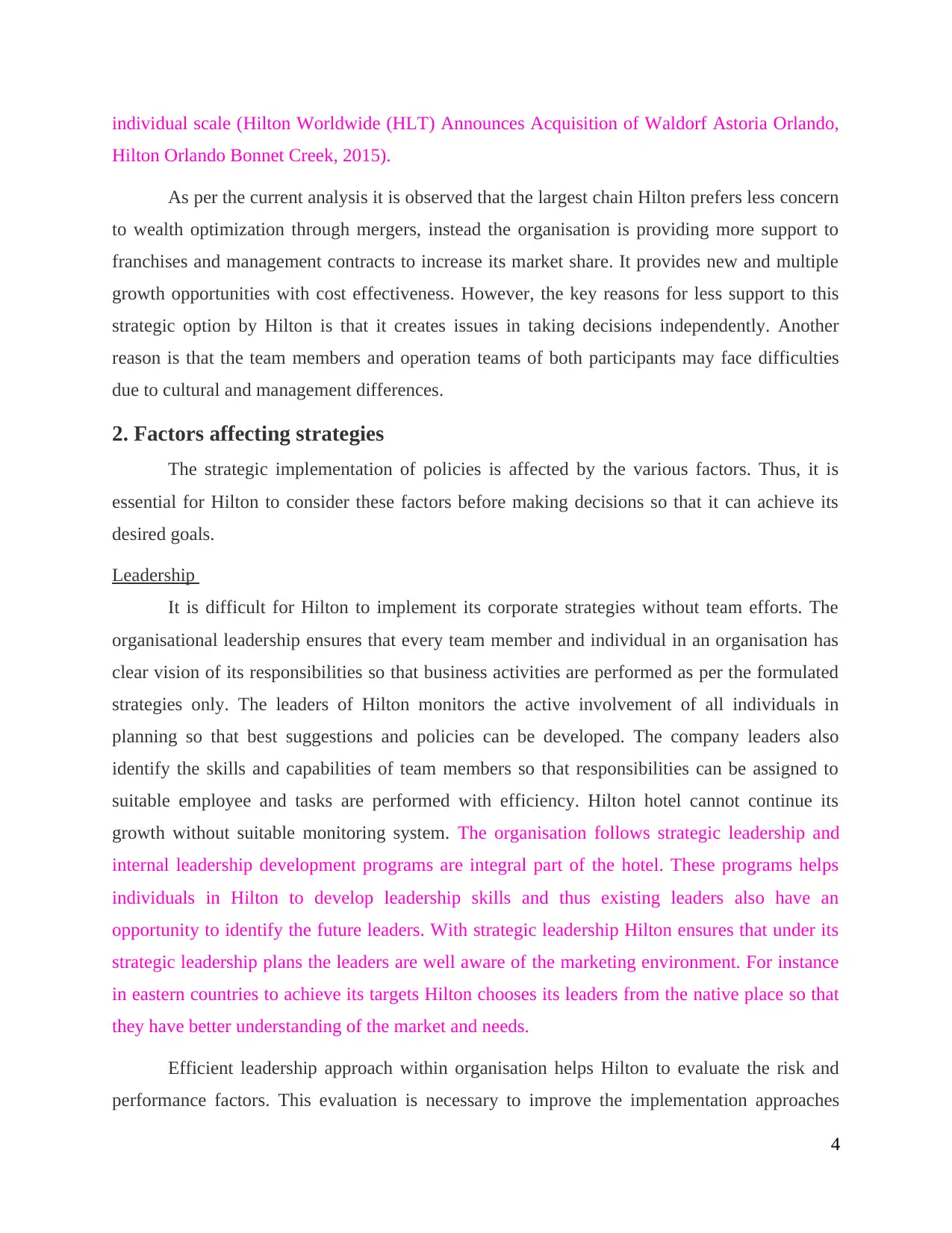
individual scale (Hilton Worldwide (HLT) Announces Acquisition of Waldorf Astoria Orlando,
Hilton Orlando Bonnet Creek, 2015).
As per the current analysis it is observed that the largest chain Hilton prefers less concern
to wealth optimization through mergers, instead the organisation is providing more support to
franchises and management contracts to increase its market share. It provides new and multiple
growth opportunities with cost effectiveness. However, the key reasons for less support to this
strategic option by Hilton is that it creates issues in taking decisions independently. Another
reason is that the team members and operation teams of both participants may face difficulties
due to cultural and management differences.
2. Factors affecting strategies
The strategic implementation of policies is affected by the various factors. Thus, it is
essential for Hilton to consider these factors before making decisions so that it can achieve its
desired goals.
Leadership
It is difficult for Hilton to implement its corporate strategies without team efforts. The
organisational leadership ensures that every team member and individual in an organisation has
clear vision of its responsibilities so that business activities are performed as per the formulated
strategies only. The leaders of Hilton monitors the active involvement of all individuals in
planning so that best suggestions and policies can be developed. The company leaders also
identify the skills and capabilities of team members so that responsibilities can be assigned to
suitable employee and tasks are performed with efficiency. Hilton hotel cannot continue its
growth without suitable monitoring system. The organisation follows strategic leadership and
internal leadership development programs are integral part of the hotel. These programs helps
individuals in Hilton to develop leadership skills and thus existing leaders also have an
opportunity to identify the future leaders. With strategic leadership Hilton ensures that under its
strategic leadership plans the leaders are well aware of the marketing environment. For instance
in eastern countries to achieve its targets Hilton chooses its leaders from the native place so that
they have better understanding of the market and needs.
Efficient leadership approach within organisation helps Hilton to evaluate the risk and
performance factors. This evaluation is necessary to improve the implementation approaches
4
Hilton Orlando Bonnet Creek, 2015).
As per the current analysis it is observed that the largest chain Hilton prefers less concern
to wealth optimization through mergers, instead the organisation is providing more support to
franchises and management contracts to increase its market share. It provides new and multiple
growth opportunities with cost effectiveness. However, the key reasons for less support to this
strategic option by Hilton is that it creates issues in taking decisions independently. Another
reason is that the team members and operation teams of both participants may face difficulties
due to cultural and management differences.
2. Factors affecting strategies
The strategic implementation of policies is affected by the various factors. Thus, it is
essential for Hilton to consider these factors before making decisions so that it can achieve its
desired goals.
Leadership
It is difficult for Hilton to implement its corporate strategies without team efforts. The
organisational leadership ensures that every team member and individual in an organisation has
clear vision of its responsibilities so that business activities are performed as per the formulated
strategies only. The leaders of Hilton monitors the active involvement of all individuals in
planning so that best suggestions and policies can be developed. The company leaders also
identify the skills and capabilities of team members so that responsibilities can be assigned to
suitable employee and tasks are performed with efficiency. Hilton hotel cannot continue its
growth without suitable monitoring system. The organisation follows strategic leadership and
internal leadership development programs are integral part of the hotel. These programs helps
individuals in Hilton to develop leadership skills and thus existing leaders also have an
opportunity to identify the future leaders. With strategic leadership Hilton ensures that under its
strategic leadership plans the leaders are well aware of the marketing environment. For instance
in eastern countries to achieve its targets Hilton chooses its leaders from the native place so that
they have better understanding of the market and needs.
Efficient leadership approach within organisation helps Hilton to evaluate the risk and
performance factors. This evaluation is necessary to improve the implementation approaches
4
⊘ This is a preview!⊘
Do you want full access?
Subscribe today to unlock all pages.

Trusted by 1+ million students worldwide
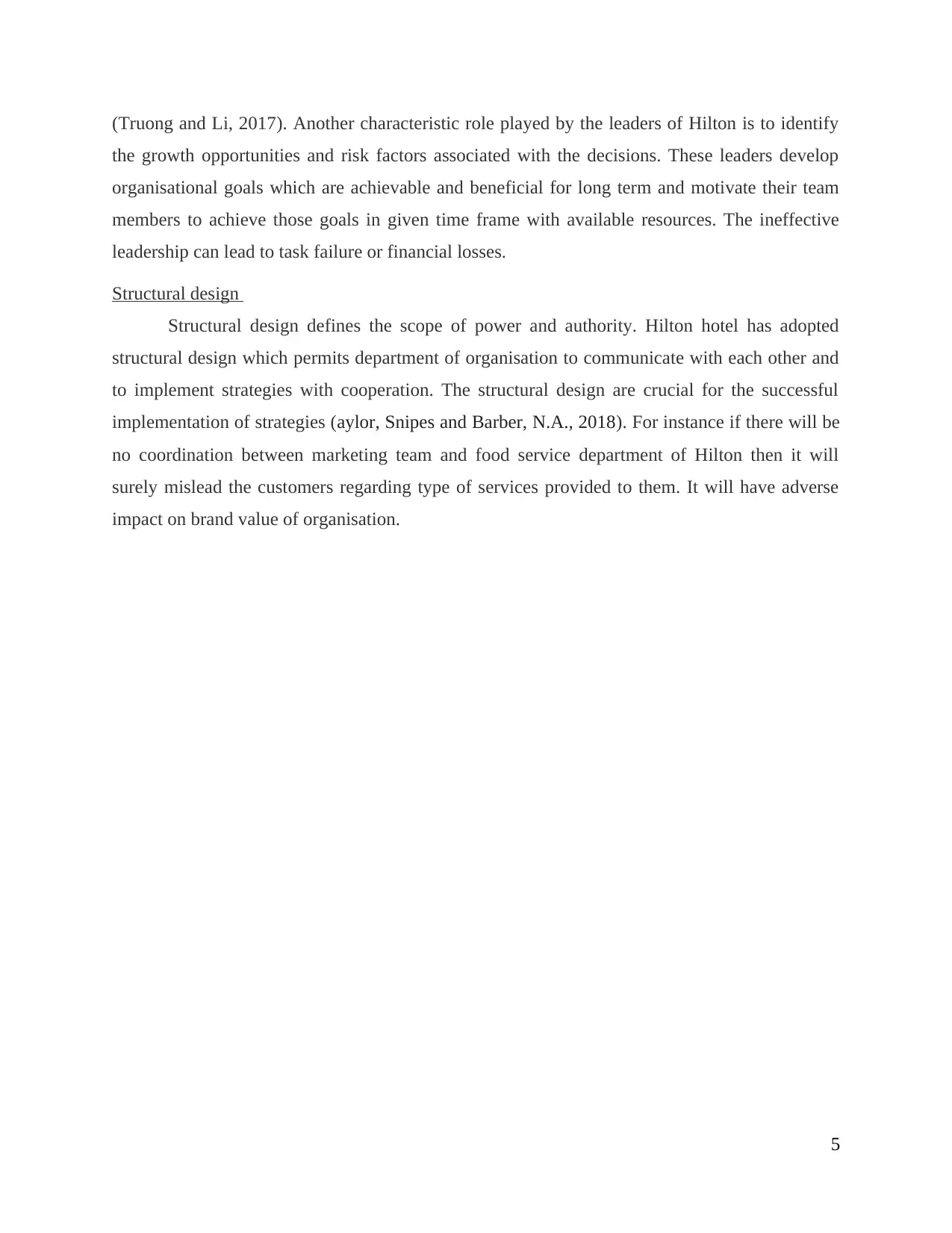
(Truong and Li, 2017). Another characteristic role played by the leaders of Hilton is to identify
the growth opportunities and risk factors associated with the decisions. These leaders develop
organisational goals which are achievable and beneficial for long term and motivate their team
members to achieve those goals in given time frame with available resources. The ineffective
leadership can lead to task failure or financial losses.
Structural design
Structural design defines the scope of power and authority. Hilton hotel has adopted
structural design which permits department of organisation to communicate with each other and
to implement strategies with cooperation. The structural design are crucial for the successful
implementation of strategies (aylor, Snipes and Barber, N.A., 2018). For instance if there will be
no coordination between marketing team and food service department of Hilton then it will
surely mislead the customers regarding type of services provided to them. It will have adverse
impact on brand value of organisation.
5
the growth opportunities and risk factors associated with the decisions. These leaders develop
organisational goals which are achievable and beneficial for long term and motivate their team
members to achieve those goals in given time frame with available resources. The ineffective
leadership can lead to task failure or financial losses.
Structural design
Structural design defines the scope of power and authority. Hilton hotel has adopted
structural design which permits department of organisation to communicate with each other and
to implement strategies with cooperation. The structural design are crucial for the successful
implementation of strategies (aylor, Snipes and Barber, N.A., 2018). For instance if there will be
no coordination between marketing team and food service department of Hilton then it will
surely mislead the customers regarding type of services provided to them. It will have adverse
impact on brand value of organisation.
5
Paraphrase This Document
Need a fresh take? Get an instant paraphrase of this document with our AI Paraphraser
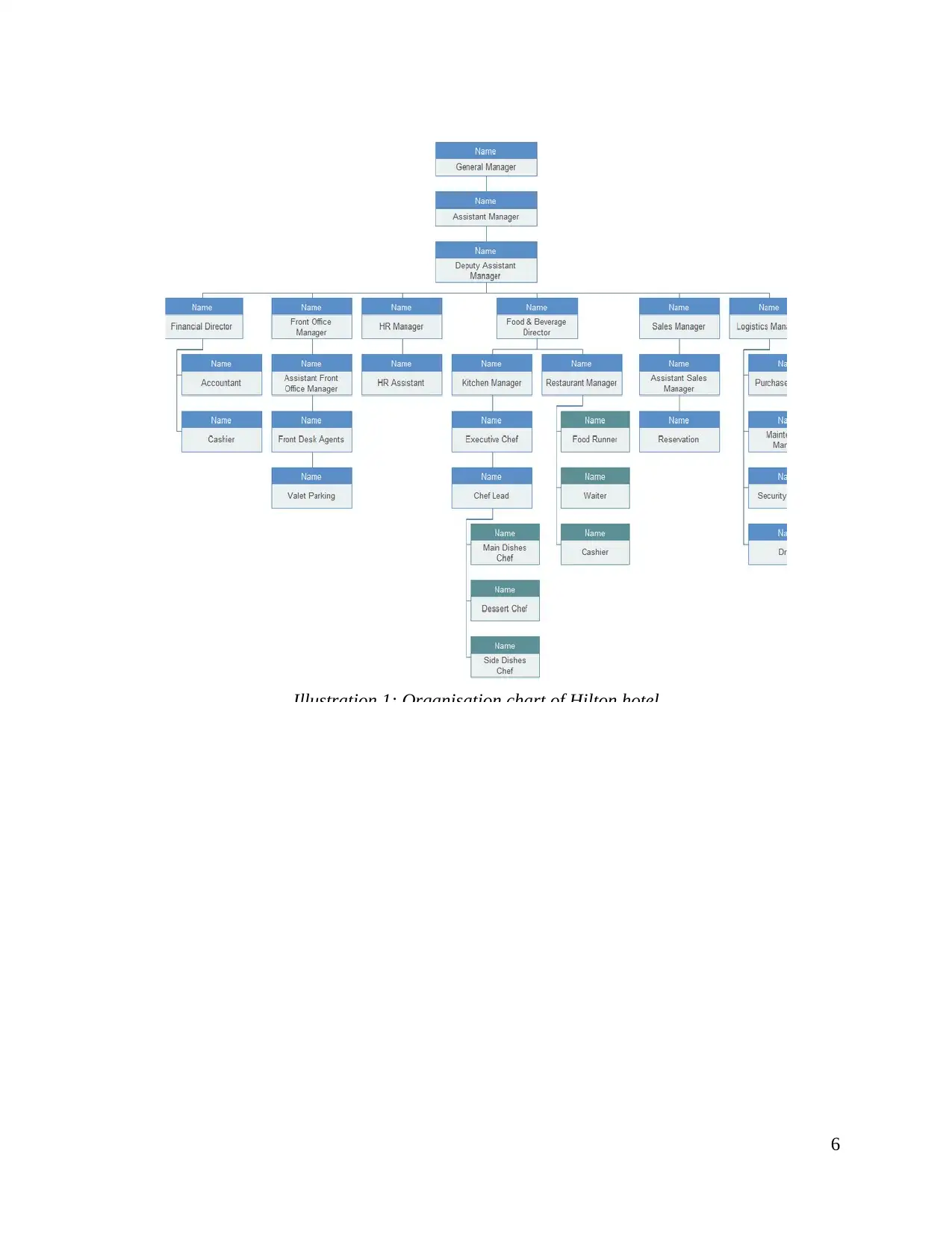
6
Illustration 1: Organisation chart of Hilton hotel
Illustration 1: Organisation chart of Hilton hotel
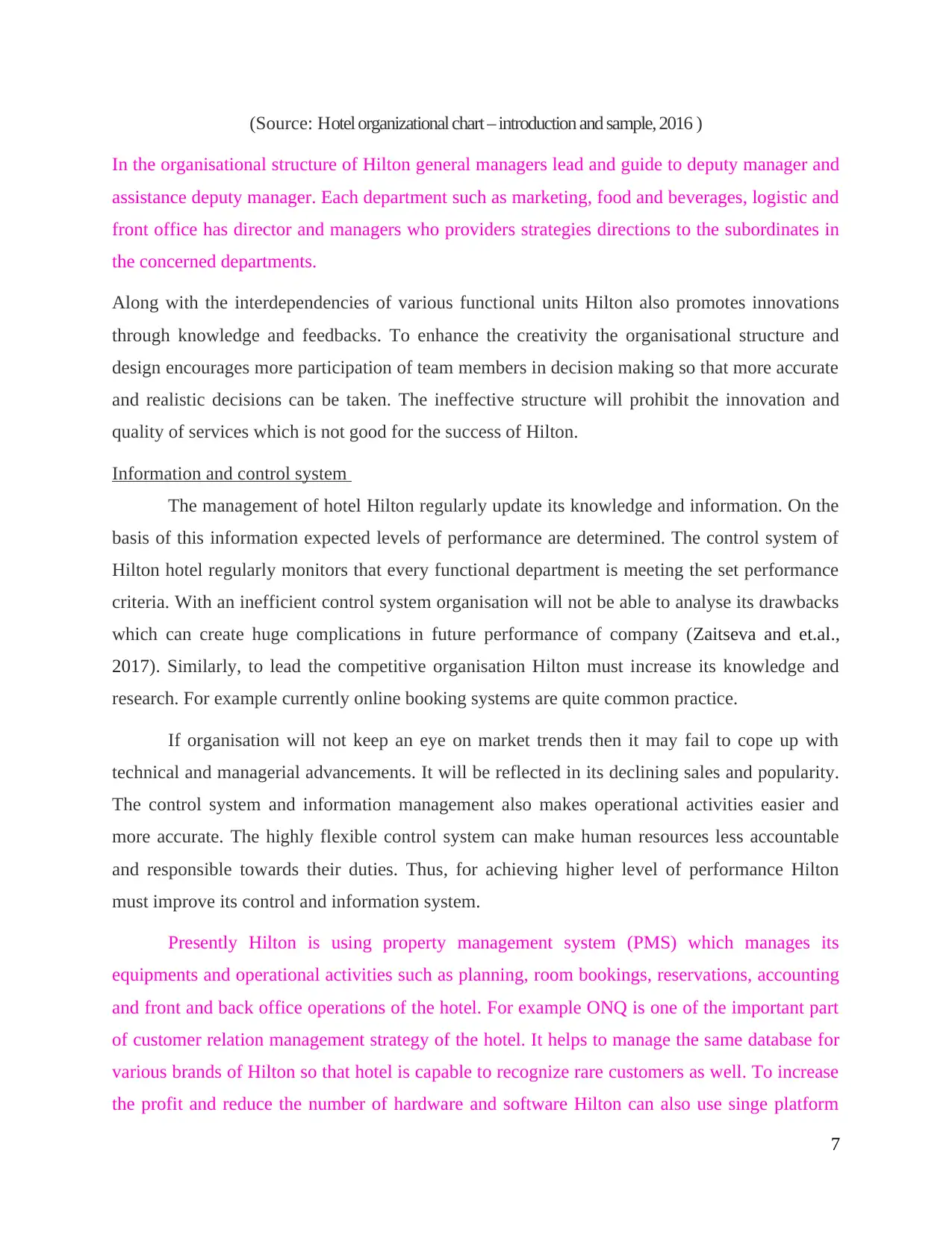
(Source: Hotel organizational chart – introduction and sample, 2016 )
In the organisational structure of Hilton general managers lead and guide to deputy manager and
assistance deputy manager. Each department such as marketing, food and beverages, logistic and
front office has director and managers who providers strategies directions to the subordinates in
the concerned departments.
Along with the interdependencies of various functional units Hilton also promotes innovations
through knowledge and feedbacks. To enhance the creativity the organisational structure and
design encourages more participation of team members in decision making so that more accurate
and realistic decisions can be taken. The ineffective structure will prohibit the innovation and
quality of services which is not good for the success of Hilton.
Information and control system
The management of hotel Hilton regularly update its knowledge and information. On the
basis of this information expected levels of performance are determined. The control system of
Hilton hotel regularly monitors that every functional department is meeting the set performance
criteria. With an inefficient control system organisation will not be able to analyse its drawbacks
which can create huge complications in future performance of company (Zaitseva and et.al.,
2017). Similarly, to lead the competitive organisation Hilton must increase its knowledge and
research. For example currently online booking systems are quite common practice.
If organisation will not keep an eye on market trends then it may fail to cope up with
technical and managerial advancements. It will be reflected in its declining sales and popularity.
The control system and information management also makes operational activities easier and
more accurate. The highly flexible control system can make human resources less accountable
and responsible towards their duties. Thus, for achieving higher level of performance Hilton
must improve its control and information system.
Presently Hilton is using property management system (PMS) which manages its
equipments and operational activities such as planning, room bookings, reservations, accounting
and front and back office operations of the hotel. For example ONQ is one of the important part
of customer relation management strategy of the hotel. It helps to manage the same database for
various brands of Hilton so that hotel is capable to recognize rare customers as well. To increase
the profit and reduce the number of hardware and software Hilton can also use singe platform
7
In the organisational structure of Hilton general managers lead and guide to deputy manager and
assistance deputy manager. Each department such as marketing, food and beverages, logistic and
front office has director and managers who providers strategies directions to the subordinates in
the concerned departments.
Along with the interdependencies of various functional units Hilton also promotes innovations
through knowledge and feedbacks. To enhance the creativity the organisational structure and
design encourages more participation of team members in decision making so that more accurate
and realistic decisions can be taken. The ineffective structure will prohibit the innovation and
quality of services which is not good for the success of Hilton.
Information and control system
The management of hotel Hilton regularly update its knowledge and information. On the
basis of this information expected levels of performance are determined. The control system of
Hilton hotel regularly monitors that every functional department is meeting the set performance
criteria. With an inefficient control system organisation will not be able to analyse its drawbacks
which can create huge complications in future performance of company (Zaitseva and et.al.,
2017). Similarly, to lead the competitive organisation Hilton must increase its knowledge and
research. For example currently online booking systems are quite common practice.
If organisation will not keep an eye on market trends then it may fail to cope up with
technical and managerial advancements. It will be reflected in its declining sales and popularity.
The control system and information management also makes operational activities easier and
more accurate. The highly flexible control system can make human resources less accountable
and responsible towards their duties. Thus, for achieving higher level of performance Hilton
must improve its control and information system.
Presently Hilton is using property management system (PMS) which manages its
equipments and operational activities such as planning, room bookings, reservations, accounting
and front and back office operations of the hotel. For example ONQ is one of the important part
of customer relation management strategy of the hotel. It helps to manage the same database for
various brands of Hilton so that hotel is capable to recognize rare customers as well. To increase
the profit and reduce the number of hardware and software Hilton can also use singe platform
7
⊘ This is a preview!⊘
Do you want full access?
Subscribe today to unlock all pages.

Trusted by 1+ million students worldwide
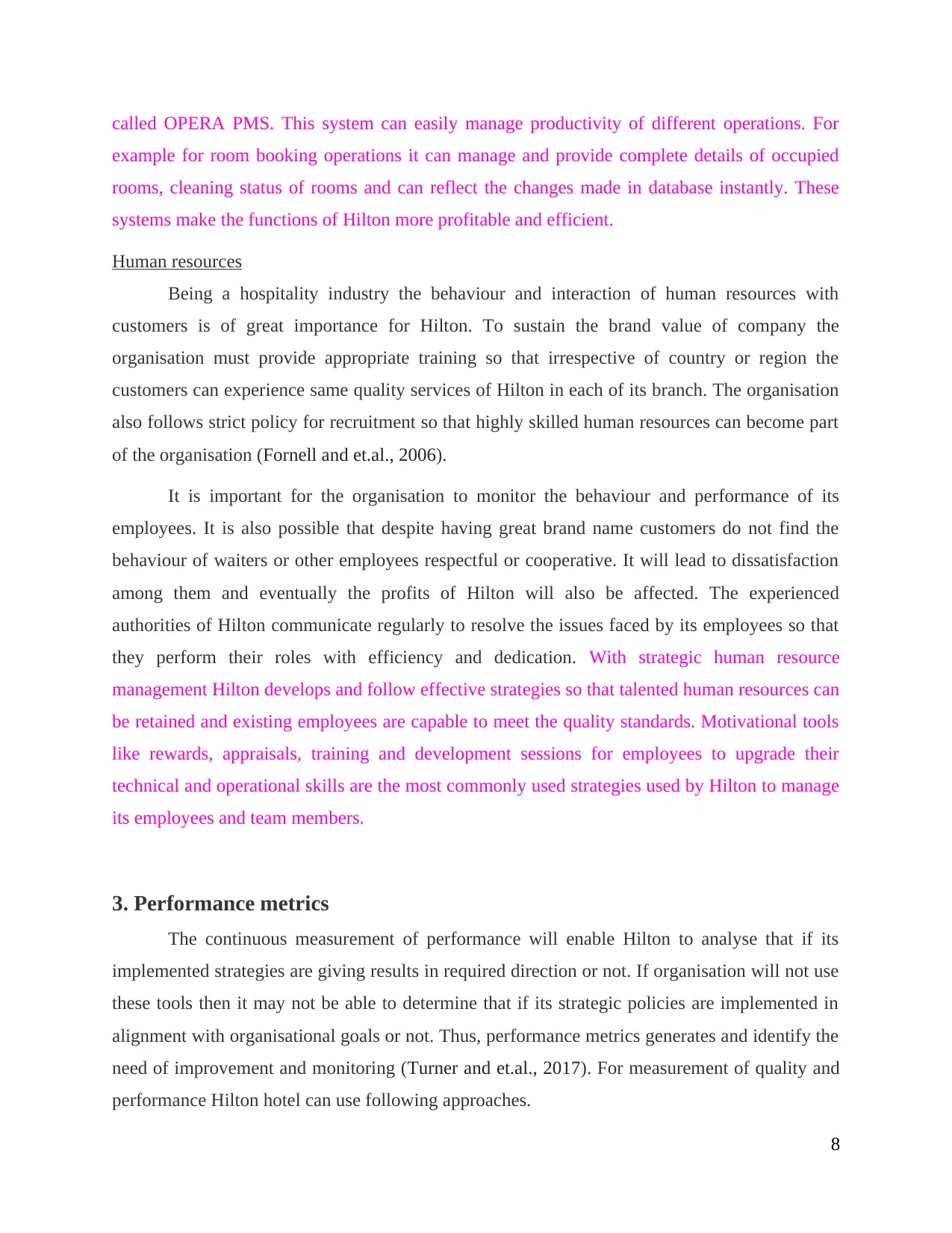
called OPERA PMS. This system can easily manage productivity of different operations. For
example for room booking operations it can manage and provide complete details of occupied
rooms, cleaning status of rooms and can reflect the changes made in database instantly. These
systems make the functions of Hilton more profitable and efficient.
Human resources
Being a hospitality industry the behaviour and interaction of human resources with
customers is of great importance for Hilton. To sustain the brand value of company the
organisation must provide appropriate training so that irrespective of country or region the
customers can experience same quality services of Hilton in each of its branch. The organisation
also follows strict policy for recruitment so that highly skilled human resources can become part
of the organisation (Fornell and et.al., 2006).
It is important for the organisation to monitor the behaviour and performance of its
employees. It is also possible that despite having great brand name customers do not find the
behaviour of waiters or other employees respectful or cooperative. It will lead to dissatisfaction
among them and eventually the profits of Hilton will also be affected. The experienced
authorities of Hilton communicate regularly to resolve the issues faced by its employees so that
they perform their roles with efficiency and dedication. With strategic human resource
management Hilton develops and follow effective strategies so that talented human resources can
be retained and existing employees are capable to meet the quality standards. Motivational tools
like rewards, appraisals, training and development sessions for employees to upgrade their
technical and operational skills are the most commonly used strategies used by Hilton to manage
its employees and team members.
3. Performance metrics
The continuous measurement of performance will enable Hilton to analyse that if its
implemented strategies are giving results in required direction or not. If organisation will not use
these tools then it may not be able to determine that if its strategic policies are implemented in
alignment with organisational goals or not. Thus, performance metrics generates and identify the
need of improvement and monitoring (Turner and et.al., 2017). For measurement of quality and
performance Hilton hotel can use following approaches.
8
example for room booking operations it can manage and provide complete details of occupied
rooms, cleaning status of rooms and can reflect the changes made in database instantly. These
systems make the functions of Hilton more profitable and efficient.
Human resources
Being a hospitality industry the behaviour and interaction of human resources with
customers is of great importance for Hilton. To sustain the brand value of company the
organisation must provide appropriate training so that irrespective of country or region the
customers can experience same quality services of Hilton in each of its branch. The organisation
also follows strict policy for recruitment so that highly skilled human resources can become part
of the organisation (Fornell and et.al., 2006).
It is important for the organisation to monitor the behaviour and performance of its
employees. It is also possible that despite having great brand name customers do not find the
behaviour of waiters or other employees respectful or cooperative. It will lead to dissatisfaction
among them and eventually the profits of Hilton will also be affected. The experienced
authorities of Hilton communicate regularly to resolve the issues faced by its employees so that
they perform their roles with efficiency and dedication. With strategic human resource
management Hilton develops and follow effective strategies so that talented human resources can
be retained and existing employees are capable to meet the quality standards. Motivational tools
like rewards, appraisals, training and development sessions for employees to upgrade their
technical and operational skills are the most commonly used strategies used by Hilton to manage
its employees and team members.
3. Performance metrics
The continuous measurement of performance will enable Hilton to analyse that if its
implemented strategies are giving results in required direction or not. If organisation will not use
these tools then it may not be able to determine that if its strategic policies are implemented in
alignment with organisational goals or not. Thus, performance metrics generates and identify the
need of improvement and monitoring (Turner and et.al., 2017). For measurement of quality and
performance Hilton hotel can use following approaches.
8
Paraphrase This Document
Need a fresh take? Get an instant paraphrase of this document with our AI Paraphraser
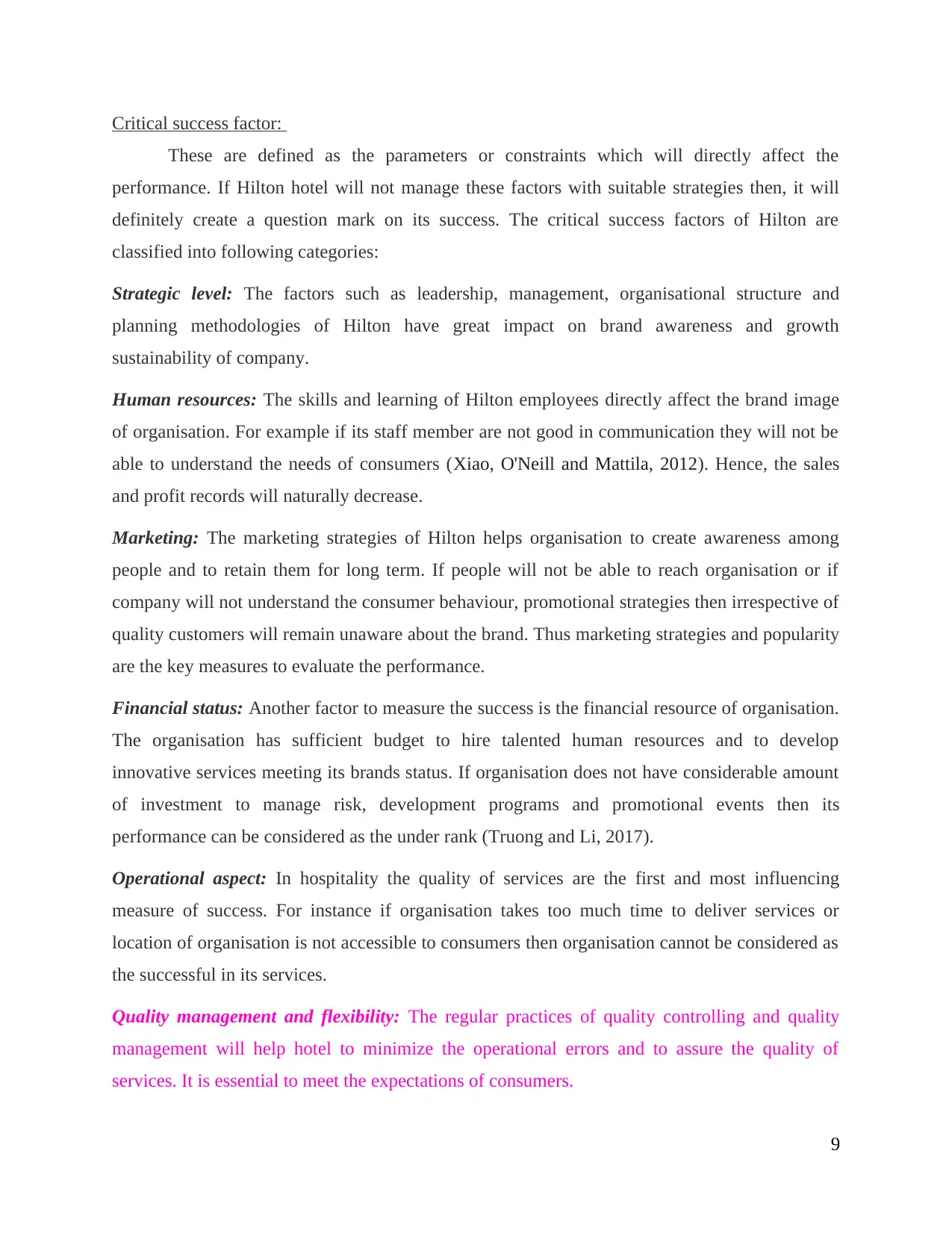
Critical success factor:
These are defined as the parameters or constraints which will directly affect the
performance. If Hilton hotel will not manage these factors with suitable strategies then, it will
definitely create a question mark on its success. The critical success factors of Hilton are
classified into following categories:
Strategic level: The factors such as leadership, management, organisational structure and
planning methodologies of Hilton have great impact on brand awareness and growth
sustainability of company.
Human resources: The skills and learning of Hilton employees directly affect the brand image
of organisation. For example if its staff member are not good in communication they will not be
able to understand the needs of consumers (Xiao, O'Neill and Mattila, 2012). Hence, the sales
and profit records will naturally decrease.
Marketing: The marketing strategies of Hilton helps organisation to create awareness among
people and to retain them for long term. If people will not be able to reach organisation or if
company will not understand the consumer behaviour, promotional strategies then irrespective of
quality customers will remain unaware about the brand. Thus marketing strategies and popularity
are the key measures to evaluate the performance.
Financial status: Another factor to measure the success is the financial resource of organisation.
The organisation has sufficient budget to hire talented human resources and to develop
innovative services meeting its brands status. If organisation does not have considerable amount
of investment to manage risk, development programs and promotional events then its
performance can be considered as the under rank (Truong and Li, 2017).
Operational aspect: In hospitality the quality of services are the first and most influencing
measure of success. For instance if organisation takes too much time to deliver services or
location of organisation is not accessible to consumers then organisation cannot be considered as
the successful in its services.
Quality management and flexibility: The regular practices of quality controlling and quality
management will help hotel to minimize the operational errors and to assure the quality of
services. It is essential to meet the expectations of consumers.
9
These are defined as the parameters or constraints which will directly affect the
performance. If Hilton hotel will not manage these factors with suitable strategies then, it will
definitely create a question mark on its success. The critical success factors of Hilton are
classified into following categories:
Strategic level: The factors such as leadership, management, organisational structure and
planning methodologies of Hilton have great impact on brand awareness and growth
sustainability of company.
Human resources: The skills and learning of Hilton employees directly affect the brand image
of organisation. For example if its staff member are not good in communication they will not be
able to understand the needs of consumers (Xiao, O'Neill and Mattila, 2012). Hence, the sales
and profit records will naturally decrease.
Marketing: The marketing strategies of Hilton helps organisation to create awareness among
people and to retain them for long term. If people will not be able to reach organisation or if
company will not understand the consumer behaviour, promotional strategies then irrespective of
quality customers will remain unaware about the brand. Thus marketing strategies and popularity
are the key measures to evaluate the performance.
Financial status: Another factor to measure the success is the financial resource of organisation.
The organisation has sufficient budget to hire talented human resources and to develop
innovative services meeting its brands status. If organisation does not have considerable amount
of investment to manage risk, development programs and promotional events then its
performance can be considered as the under rank (Truong and Li, 2017).
Operational aspect: In hospitality the quality of services are the first and most influencing
measure of success. For instance if organisation takes too much time to deliver services or
location of organisation is not accessible to consumers then organisation cannot be considered as
the successful in its services.
Quality management and flexibility: The regular practices of quality controlling and quality
management will help hotel to minimize the operational errors and to assure the quality of
services. It is essential to meet the expectations of consumers.
9
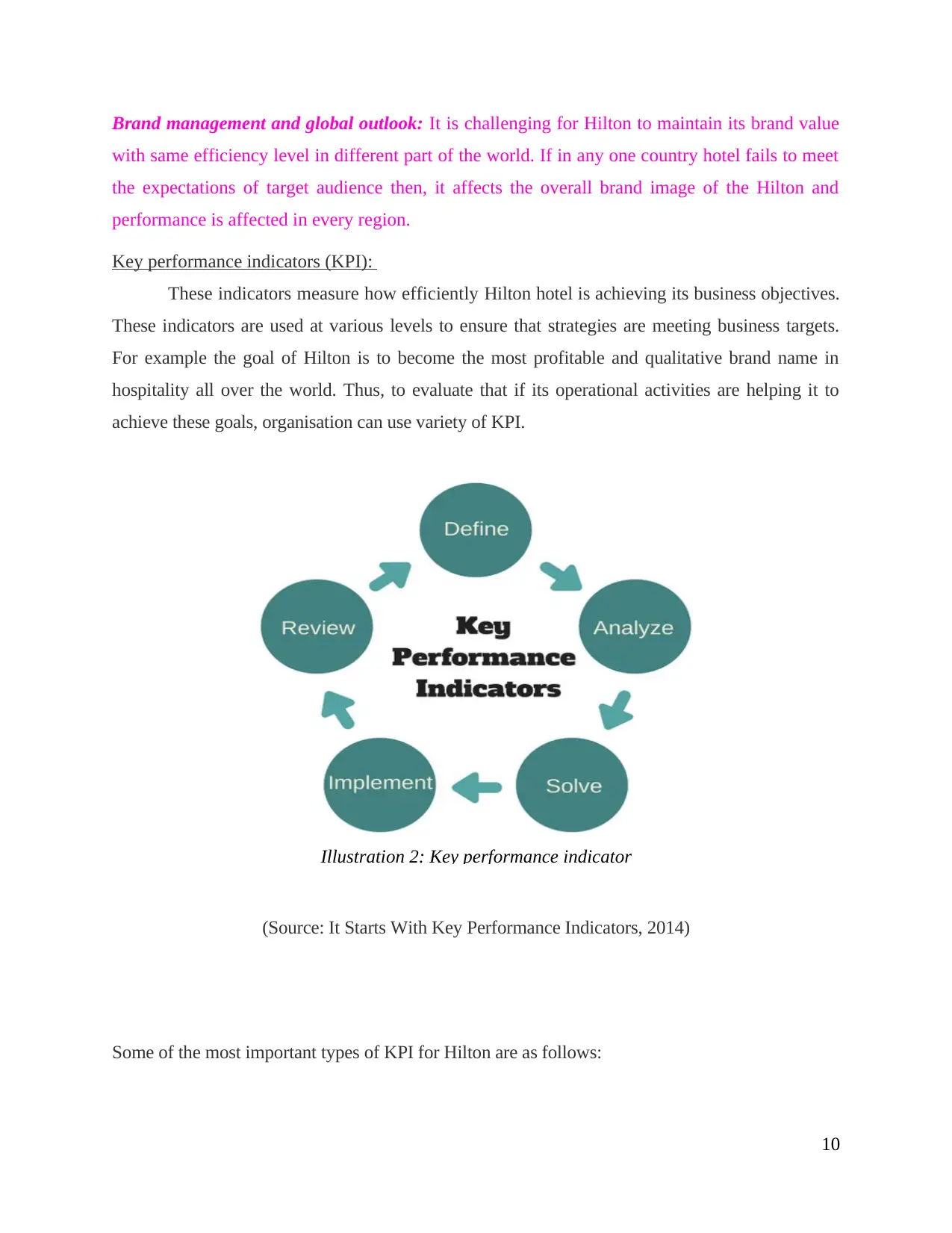
Brand management and global outlook: It is challenging for Hilton to maintain its brand value
with same efficiency level in different part of the world. If in any one country hotel fails to meet
the expectations of target audience then, it affects the overall brand image of the Hilton and
performance is affected in every region.
Key performance indicators (KPI):
These indicators measure how efficiently Hilton hotel is achieving its business objectives.
These indicators are used at various levels to ensure that strategies are meeting business targets.
For example the goal of Hilton is to become the most profitable and qualitative brand name in
hospitality all over the world. Thus, to evaluate that if its operational activities are helping it to
achieve these goals, organisation can use variety of KPI.
(Source: It Starts With Key Performance Indicators, 2014)
Some of the most important types of KPI for Hilton are as follows:
10
Illustration 2: Key performance indicator
with same efficiency level in different part of the world. If in any one country hotel fails to meet
the expectations of target audience then, it affects the overall brand image of the Hilton and
performance is affected in every region.
Key performance indicators (KPI):
These indicators measure how efficiently Hilton hotel is achieving its business objectives.
These indicators are used at various levels to ensure that strategies are meeting business targets.
For example the goal of Hilton is to become the most profitable and qualitative brand name in
hospitality all over the world. Thus, to evaluate that if its operational activities are helping it to
achieve these goals, organisation can use variety of KPI.
(Source: It Starts With Key Performance Indicators, 2014)
Some of the most important types of KPI for Hilton are as follows:
10
Illustration 2: Key performance indicator
⊘ This is a preview!⊘
Do you want full access?
Subscribe today to unlock all pages.

Trusted by 1+ million students worldwide
1 out of 16
Related Documents
Your All-in-One AI-Powered Toolkit for Academic Success.
+13062052269
info@desklib.com
Available 24*7 on WhatsApp / Email
![[object Object]](/_next/static/media/star-bottom.7253800d.svg)
Unlock your academic potential
Copyright © 2020–2025 A2Z Services. All Rights Reserved. Developed and managed by ZUCOL.





